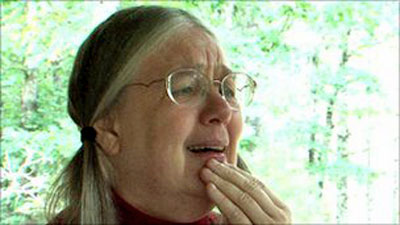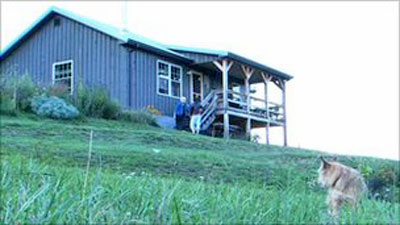|

by Julie Beck
September 13, 2011
from
PopSci Website
|
Corruption of Science -
Popular Science Magazine Implies That Sensitivity to
Evil Wi-Fi is Imaginary, Mocks Community of Wi-Fi
Refugees
in Hills of Appalachia
|

Telescope at National Radio Astronomy Observatory
in Green Banks,
Virginia
Jarek Tuszynski/Wikimedia
Commons
It's safe to say that most of us have
come to accept, if not embrace, the abundance of wireless technology
in our everyday lives. Not so for certain Americans who believe
they suffer from Electromagnetic Hypersensitivity, or
EHS.
According
to the BBC, five percent of Americans think that exposure to
electromagnetic fields created by
Wi-Fi and
mobile phones are
causing them to suffer,
-
headaches
-
muscle spasms
-
burning skin
-
chronic pain
And some of these people are seeking refuge in the
secluded mountains of Appalachia.
Towns like
Green Bank, West Virginia are part of the U.S. Radio
Quiet Zone, 13,000 square miles of wireless free land created to
keep transmissions from interfering with radio telescopes like those
owned by the military and the
National Radio Astronomy Observatory.
Some of those who believe (and we keep saying "believe" because
there is some controversy about the medical validity of the claims)
they feel ill effects from Wi-Fi have sought refuge in these hills.
A University of Maryland physics professor quoted in the BBC piece
disagrees with the self-diagnoses, saying that Wi-Fi radiation is
far too weak to cause changes in body chemistry and make people
sick.
The World Health Organization fact sheet
on EHS says that,
“the symptoms are certainly real,” but that “EHS is
not a medical diagnosis, nor is it clear that it represents a single
medical problem.”
As of 2010, Sweden was the only country that
recognizes EHS as a functional impairment, even paying to have
sufferers' homes electronically “sanitized” by installing metal
shielding.
However, a study conducted by Louisiana State University claims to
prove that the effects of radiation are real, relying on the results
of an experiment in which a self-diagnoses sufferer was bombarded
with both real and fake rays and asked about her symptoms.
But neither this study nor any other
similar studies have been accepted by either the medical or or
scientific communities.
Still, the sufferers of whatever this is, or isn't, seem to find
some relief in moving to the mountains of West Virginia.
'Wi-Fi Refugees'
...Shelter
in West Virginia Mountains
by Jane O'Brien and
Matt Danzico
BBC News, Green Bank
12 September 2011
from
BBC Website
|
Dozens of Americans who claim to have been made ill by
Wi-Fi and
mobile phones have flocked to the town of
Green Bank, West Virginia |
There are five billion mobile phone
subscriptions worldwide and advances in wireless technology make it
increasingly difficult to escape the influence of mobile devices.
But while most Americans seem to embrace continuous connectivity,
some believe it's making them physically ill.
Diane Schou is unable to hold back the tears as she describes
how she once lived in a shielded cage to protect her from the
electromagnetic radiation caused by waves from wireless
communication.
"It's a horrible thing to have to be
a prisoner," she says. "You become a technological leper because
you can't be around people."
"It's not that you would be contagious to them - it's what
they're carrying that is harmful to you."
Ms Schou is one of an estimated 5% of
Americans who believe they suffer from Electromagnetic
Hypersensitivity (EHS), which they say is caused by exposure to
electromagnetic fields typically created by
mobile phones, Wi-Fi and
other electronic equipment.
Hiding in a cage
Symptoms range from acute headaches, skin burning, muscle twitching
and chronic pain.

Diane Schou says she
was forced to live
in a shielded cage in Iowa, prior to moving to
West Virginia
"My face turns red, I get a
headache, my vision changes, and it hurts to think. Last time [I
was exposed] I started getting chest pains - and to me that's
becoming life-threatening," Ms Schou says.
To alleviate the pain, her husband built
an insulated living space known as a
Faraday Cage.
He covered a wooden frame with two layers of wire mesh and a door
that could be sealed shut to prevent radio waves from entering.
Diane spent much of her time inside it, sleeping on a twin mattress
on a plywood base.
"At least I could see my husband on
the outside, I could talk to him," she says.
Diane believes her illness was triggered
by emissions from a
mobile phone mast.
Her symptoms were so severe that she abandoned her family farm in
the state of Iowa and moved to
Green Bank, West Virginia
- a tiny village of 143 residents in the heart of the
Allegheny Mountains.
Outlawed
wireless technology
Green Bank is part of the US Radio Quiet Zone, where wireless is
banned across 13,000 sq miles (33,000 sq km) to prevent
transmissions interfering with a number of radio telescopes in the
area.
The largest is owned by the National Radio Astronomy Observatory and
enables scientists to listen to low-level signals from different
places in the universe. Others are operated by the US military and
are a critical part of the government's spy network.
As a result of the radio blackout, the Quiet Zone has become a haven
for people like Diane, desperate to get away from wireless
technology.

The world's largest,
fully steerable radio telescope
is operated in the
town of Green Bank
"Living here allows me to be more of
a normal person. I can be outdoors. I don't have to stay hidden
in a Faraday Cage," she says.
"I can see the sunrise, I can see the stars at night, and I can
be in the rain.
"Here in Green Bank allows me to be with people. People here do
not carry cell phones so I can socialize. I can go to church, I
can attend some celebrations, I can be with people. I couldn't
do that when I had to remain in the Faraday Cage."
But EHS is not medically recognized in
the U.S.
Debated 'condition'
The wireless association,
CTIA, says that scientific evidence
overwhelmingly shows that wireless devices, with the limits
established by government regulators, do not pose a public health
risk or cause any adverse health effects.
And the World Health Organization (WHO), while acknowledging that the
symptoms are genuine and can be severe, says:
"EHS has no clear diagnostic
criteria and there is no scientific basis to link EHS symptoms
to EMF (electromagnetic field) exposure. Further, EHS is not a
medical diagnosis, nor is it clear that it represents a single
medical problem."
However, new research by scientists at
Louisiana State University and published by the International
Journal of Neuroscience, claims to show that EHS can be caused by
low frequency electromagnetic fields found in the environment.
"Towards the end of my
normal life
when I still could watch
television I could actually
cut my pain off and on
with the remote control device"
Nichols Fox
West Virginia resident
"The study provides direct evidence
that linking human symptoms with environmental factors, in this
case EMF," says Dr Andrew Marino, a neurology professor who led
the study.
"It's a watershed in that regard. There have been no previous
studies that scientifically assess whether electromagnetic
fields in the environment could produce human symptoms.
"And the symptoms matter because they are the first steps that
show how EMFs produce human disease."
Scientists conducted a number of tests
on a 35-year-old physician who had diagnosed herself with EHS.
She was seated on a wooden chair while voltage was applied to metal
plates for pulses of 90 seconds to create a series of magnetic
fields. The woman was asked to describe her symptoms after each
exposure and after random sham exposures when, unknown to her, there
was no voltage.
She reported headaches, pain and muscle twitching during the genuine
exposures and no symptoms for the majority of the sham exposures.
The scientists concluded that such consistency could not be
attributed to chance.
But other experts still disagree that a link exists.
Technological
'ignorance'
Bob Park is a physics professor at the University of Maryland.
He says that the radiation emitted by Wi-Fi is simply too weak to
cause the type of changes in the body's chemistry that could make
people sick.

Nichols Fox lives
alone in a home
powered primarily by
gas just outside the Quiet Zone
"The bigger problem that we face is
that in our society, driven by technological change, people have
very little education," he says.
"There are lots of things people need to learn and they're not
learning it. The thing that's going to kill them is ignorance."
Seventy-year-old Nichols Fox says she
understands such skepticism - it took several years before she
became convinced that her debilitating pain and fatigue were caused
by electromagnetic radiation emitted by her computer.
"Towards the end of my normal life
when I still could watch television I could actually cut my pain
off and on with the remote control device," she says. "It was
such an enormously clear association there was just no denying
it."
Her symptoms are so severe that she has
isolated herself almost entirely, living in a remote house
surrounded by fields and woods just outside the Quiet Zone.
She says
even the low-level electromagnetic fields generated there affect her
health.
She uses hardly any electricity - her refrigerator operates on gas,
light comes from kerosene lamps and a wood-burning stove provides
most of her heat.
A thermostat is set to switch on electric heaters if the temperature
drops to a level where she is in danger of hypothermia.
"It's so important that people
understand that this is a very serious disability, it's a
life-changing disability. It leads to an earlier death - I have
absolutely no doubt about that and I think it's just unfortunate
that this is not recognized," she says.
But even in this secluded part of
America, the incursion of wireless technology is relentless.
Planning permission has been granted for a
cell tower a few miles
from her home, and Nichols says she'll have to move.
"I'm getting older and I really
don't know where I'm going to go or what I'm going to do," she
says. "It's really quite frightening."
|




